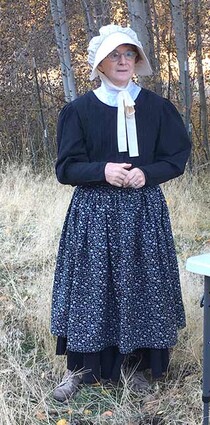Spirits of times past arise at cemetery
Last updated 10/31/2017 at Noon

Sue Stafford
Martha Taylor Cobb Hindman Olson regales visitors to Camp Polk with the stories of her many years on the land.
Last Friday, October 27, on a perfect late-autumn afternoon, the spirits of early Sisters residents were up and roaming about at Camp Polk Meadow and the Camp Polk Cemetery.
As part of the Deschutes Land Trust annual Spirits of Camp Polk walk, visitors were treated to a living history event peopled by volunteers playing the roles of Samuel Hindman, his daughter-in-law Martha, and native women who visited the meadow long before any white settlers arrived, as well as numerous early Sisters settlers up in the cemetery.
The Native Americans had camped in the meadow for centuries, where they found abundant food and water. The Wascos and Piautes made seasonal migrations through this area that served as the hub of all the surrounding waterways - the Deschutes River, Whychus Creek, Indian Ford Creek, the Metolius River, and numerous other creeks and rivers.
In the early 1800s, European trappers and explorers entered the area. In 1843, Captain John C. Fremont crossed the meadow on his way to California. Migration west on the Oregon Trail followed, as adventurers, cattlemen, and gold seekers established trails across the Cascades from the Willamette Valley to Central Oregon.
In 1865, the meadow became known as Camp Polk when returning Civil War soldiers from Polk County in the valley were sent to establish a fort to protect travelers along the Santiam Wagon Road from "hostile Indians," of which there were none at the time. They were commanded by Captain Charles La Follette and were only encamped in the meadow from September 1865 through May 1866.
After traveling west from Omaha on the Oregon Trail in 1862, to the Albany area, Samuel and Jane Hindman came over the mountains and settled at the abandoned Camp Polk. In 1871, with the help of friends, Samuel built the 75-by-50-foot barn and stable using hand-hewn ponderosa beams, one of which came from one single tree. The outside was shingled with western larch. Unfortunately, only the framing timbers remain standing today.
The Hindman Station, as it was called, provided for travelers with a store, lodging, and food and shelter for their animals. In 1875, the first post office west of Prineville was established at Hindman Station. Samuel had to travel over the mountains to Albany for supplies not available east of the mountains.
This was a successful period in Samuel's life as he rose in prominence to become the first justice of the peace for Crook County (which included all the area of later Deschutes and Jefferson counties) and he moved to Prineville. In 1884 Jane died and was buried in Prineville.
When a new bridge across Whychus Creek was built in Sisters in 1891, directing travelers away from the Hindman Bridge at Lower Bridge, Hindman Station lost its position of prominence. The post office had been moved to Sisters in 1887. After returning to Albany at age 64, a bad second marriage and debts brought Samuel back to Camp Polk with his son Charlie. At age 94 he died and was buried in Prineville next to Jane.
Although Samuel and Jane are not lying in the quaint Camp Polk cemetery, many who came after them are, and visitors on Friday were treated to snippets of their life stories by actors dressed in authentic early settler garb. Local characters like A. J. Weston, who enjoyed his liquor, worked at the sawmill, spending his off time at the Owl Tavern. A. J. shared his side of the story regarding the murder of Robert Klug, supposedly killed by A. J. because of reportedly hidden gold in Klug's cabin. A. J. was found guilty, spent some time in prison in Salem, was pardoned by the governor, and returned to his stool at the Owl Tavern.
The Farthings shared their sad story of how they outlived all of their children and how Warren was cared for by grandson Vine after his wife's death. The Farthings owned and ran the community hall in Sisters that hosted dances, plays, community events, skating, and traveling shows. Molly became known as Aunt Molly to the residents of Sisters until her death in 1934. Her grandson Vine died in 1989 and was probably known by longtime Sisters residents.
Other characters included Joe Claypool who owned the roadhouse at Fish Lake and died in 1933 at the age of 83. Theodor Borstal accidently shot himself while watching sheep at Dutchman's Flat. Alfred Cobb ran the Cobb roadhouse, the first development on the current Lazy Z ranch, and the only place to eat and sleep between Fish Lake and Prineville.
The Fryrears, the Taylors, Martha Taylor Cobb Hindman Olson, Perry South, the Grahams of Graham Corral, and Ray Eyerly, who was named the State Painter by Governor Tom McCall, are all buried in the Camp Polk Cemetery and came forward last Friday to share their stories.
After each spirit spoke, a candle was placed on their grave in remembrance of them and their life in Sisters.
The Deschutes Land Trust cemetery event is the brainchild of Kelly Madden, retired educator, Deschutes Land Trust volunteer, and member of the Deschutes County Historic Landmarks Commission.

















Reader Comments(0)